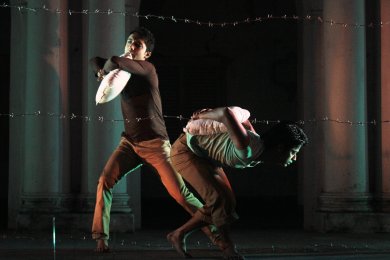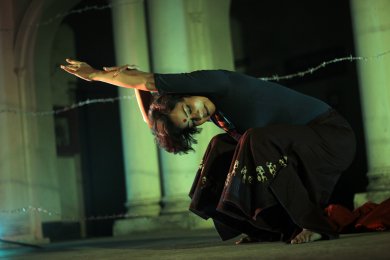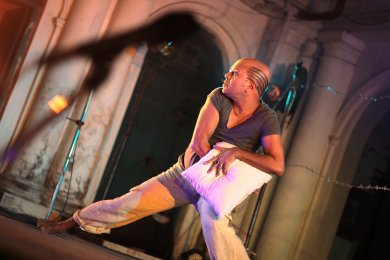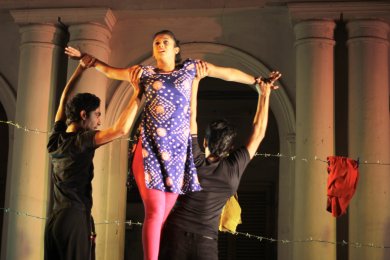
|   |

|   |
Roopantar: A venture to establish Identity - Sulagna Mukhopadhyay e-mail: sulagna64@gmail.com Photos courtesy: Sapphire January 5, 2015 The Jorashanko Natmondir (Tagore’s House) is the stage along with rooms behind the pillars. As the audience enters the place, their eyes are drawn to the iron boundary running vertically across the open stage. It reminds the critic immediately of an advertisement, in which while playing with a football, the ball suddenly crosses the border and falls into the hands of another boy standing on the opposite side of the border. Thus, they become friends. Sapphire Creations Dance Company presented Roopantar (Transcending Borders) on Dec 18, 2014 as a continuation of Sapphire Quarterly Arts Series. Here Sudarshan Chakravorty, who conceptualized and choreographed the production, talks about the different social and political boundaries that we are combating every moment. The beginning is quite different. Theatre actors like Anirban Ghosh, Aruk Shome, Bhaskar Bhaduri, Isanjit De, Shankar Sheet and Arindam Pal enter the stage with an Identity Card and wearing a frown on their faces. Their expression is that of agony and irritation that influences the audience. It creates a bizarre atmosphere and audience is startled in a very subtle way, unable to create connection between the dance production and the actors present on stage and their motifs. A group of dancers quietly approach the stage with a pillow in hand, which resembles the comfort zone of human world, beyond which we cannot think. A song by Lalon engulfs the entire atmosphere. The song is sung by renowned folk singer Dipannita Acharya. She has a rustic voice, which is befitting for folk songs.  Koushik Das & Prasenjit Dutta  Paramita Saha  Sudarshan Chakravorty  Rima Haldar, Koushik Das, Prasenjit Dutta Clad in costumes showcasing different religions, the dancers appear on the stage one by one, each with his or her own agenda. They superficially project through mimes, their ideology on crossing borders. But the question ‘how?’ remains unresolved until they come to a point, when they decide to join hands and take a pledge to relinquish all borders existing in this society. In today’s context, Roopantar is a relevant production, and the choreographer Sudarshan goes against the tide to create consciousness on issues, which might perplex us. The distinction created by man between himself and a woman, the manner in which a woman is manhandled by him, the way the male society looks at ‘rape’ is condemned by Sudarshan Chakravorty through his body language. He alternately projects the two identities - man and woman. His use of the expression karuna in this part is amazing. He questions his audience on the male authoritarian, which imbalances the ecology, where man and woman are both a part. As the dancer puts his body forth to cross the iron border, which is quite metaphorical, others surround him and surmounting the barrier becomes implausible. This is followed by political barriers, which stops a person from traversing the world. The dancers form geometrical patterns to express their concern about the geopolitical borders set by politicians. They blend Bharatanatyam with contemporary movements. Paramita Saha, Koushik Das, Ankita Gupta, Prasenjit Dutta, Rima Haldar and Manju Roy depict the various characters. The scenes segue from one theme to the other without the slightest disruption. Sounak Chattopadhyay’s rendition of ragas along with Iman Chakraborty’s songs of Tagore gives an extra edge to the production. The final song of Tagore sung by not only the three singers, but also the actors and the dancers Viswo sathe joge jethay biharo leaves the audience spellbound. The production is unique. But it would be enhanced if Sudarshan includes poems, which might emphasize the message he wants to establish through his form of art. Sulagna Mukhopadhyay was trained in Bharatanatyam by Guru Thankamani Kutty and Indian folk by Late Botu Pal. She has an M.A. in Comparative Literature and has freelanced for various leading newspapers of Kolkata like The Telegraph, The Statesman and Ananda Bazar Patrika. She has written articles on dance and gender issues. She is a teacher of South Point School since 1996. |